The Four States of Water in Oil
Why is this important? Water is a highly destructive contaminant. It’s important to know how it behaves and coexists when it invades our oil, machine or system.
The understanding of its coexistence has evolved over the years from the initial perception of two states, then three and now four. Three of these states are clearly visible and not only tell us about the presence of water but also about the condition of the oil. By far, the most important, effective and practical condition monitoring sensor is the eyeometer (I love that word!). It is imperative that we train our eyes and be keen inspectors which are integral to Inspection 2.0. If you want world-class reliability, you must have world-class lubrication. If you want world-class lubrication, you must have a world-class inspection. Back to water...
How Many States?
Historically, water contaminated oil has been said to exist in two states, the first dissolved water (bound molecularly in the matrix of the oil) and the second free water (not molecularly bound). In the last 30 years or so most of the literature, including Noria’s publications, refers to water as having three states. Free water has been redefined as being water that, by force of gravity, will phase-out of the oil. This means it will separate below (most common) or above the oil phase depending on oil density.
The new third state is emulsified water. Water that is held tightly in micro-globules in the oil is no longer referred to as free water. Instead, it has been more accurately referred to as emulsified water or a microemulsion. Emulsified water does not separate quickly, or at all in many cases. This is due to polarity, relating to cohesive forces between the water and the oil, especially its additives. Also influencing this is the high oil-water interfacial area which relates to the contact area between the water and the oil. The smaller the water globule, the greater the relative interfacial area of water contacting the oil, which holds the water tighter and longer in the body of the oil. Stoke's Law plays a role too (Google it).
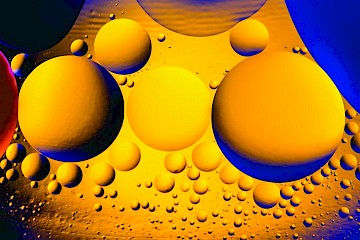 These micro-globules are basically locked in the body of the oil and as such become a homogeneous part of the oil, physically and chemically. They are what causes the oil to become hazy or cloudy depending on oil concentration. This noteworthy parameter is referred to as turbidity, which actually increases the oil’s viscosity. Figure 1 shows three samples of hydraulic fluid. The first sample is dry oil while the middle sample and the right sample have increasing amounts of emulsified water, hence the cloudy, turbid appearance.
These micro-globules are basically locked in the body of the oil and as such become a homogeneous part of the oil, physically and chemically. They are what causes the oil to become hazy or cloudy depending on oil concentration. This noteworthy parameter is referred to as turbidity, which actually increases the oil’s viscosity. Figure 1 shows three samples of hydraulic fluid. The first sample is dry oil while the middle sample and the right sample have increasing amounts of emulsified water, hence the cloudy, turbid appearance.
There are two common ways emulsified water can form in the oil. The first is from colloidal condensation due to a supersaturated state of water in oil. This occurs when the oil’s temperature drops below its dew point. The dissolved water concentration in oil is 100% when it is at its dew point. The colder the oil gets, the cloudier the oil becomes from condensation. The dew point temperature is influenced by the polar chemistry of both the oil’s base stock and additives.
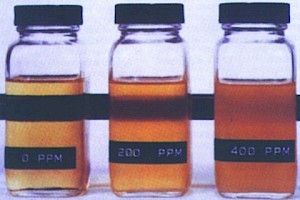
The second way an emulsion can occur is from shear or mechanical agitation. In this case, free water is crushed by high mechanical mixing into the oil, similar to how mayonnaise is made in a blender. Crushing can occur by pumping, by fine filtration, from turbulent flow and at frictional zones (gears, bearings, etc.). Crushing can increase the interfacial (touching) surface area between the oil and the water by over one million times. This, combined with polar chemistry, locks the water in the oil, preventing it from stratifying downward easily. Typically, the size of micro-globules of water in oil is about 5-10 microns.
Invert-Emulsion, the 4th State
Above, I referred to water as being emulsified in the form of micro-globules. In such a case, the oil is the continuous phase and the water globules are discontinuous (separated by oil). The 4th state relates to the inversion of water and oil as an emulsion. When an inversion happens, the water is in the continuous phase and the oil is in the discontinuous phase. The oil is the globule or micro-globule, not the water.
This 4th state typically occurs either at the interface between oil and free water or in the rare case when there is more water than there is oil in a turbulent vessel or circulating system. Many metal-working fluids and coolants are high-water based fluids, i.e., oil-in-water emulsions. The same is true for certain fire-resistant hydraulic fluids.
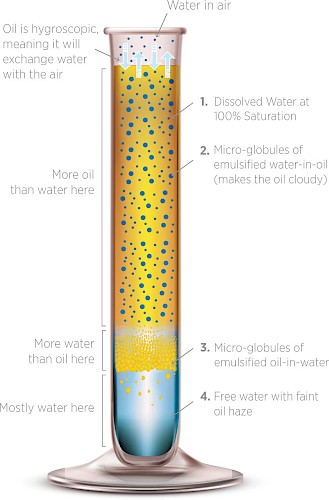
Emulsified oil-in-water can easily be composed of 90% water or more. The high density of the water holds it down in sumps and reservoirs, meaning it is generally not as mobilized like its unruly sibling (water-in-oil). Figure 3 shows two oil samples that are clearly exhibiting evidence of all four states of water in oil.
Figure 2 shows an annotated illustration of the common appearance and locations of all four states of water and oil. At the top, you see dissolved water (but not really). Just as water in humid air is invisible to the eye, the same is the case with dissolved water in oil. It is worth noting that all lubricants have dissolved water to some degree.
Oil is hygroscopic and as such will draw water directly from humid air above. For instance, if the air has a relative humidity of 80% then a hygroscopic oil in contact with the air will absorb water from it until it is also at 80% relative humidity. At which point the air and the oil are in equilibrium.
The Most Destructive State
Emulsified water-in-oil is the greatest offender in terms of damage to the oil and the machine. It's enormous oil-water interfacial puts it at high risk to incite considerable harm, both physically and chemically. Most serious is the fact that it is mobilized, meaning that it travels unrestricted to the far reaches of the machine including those critically sensitive frictional surfaces. Wherever the oil goes, so goes this aggressive contaminant.
As we’ve said many times in this publication and throughout Noria training courses... get water under control! Recognize it quickly, remove it quickly. Inspection is your first line of defence. Any visual form of water should be of serious concern. Oil analysis is even more revealing. Figure out where it’s coming from and stop its ingression into the oil.
Different Oils; Different States
Know your oils from the standpoint of how water behaves and co-exists with them. Engine oils for instance are loaded with polar additives such as detergents, dispersants, antiwear additives, etc. The free water state is unlikely with engine oil, even if there is 90 per cent water. Conversely, emulsions quickly and tightly form between water and engine oil.
Healthy, clean turbine oil is at the other extreme. It rapidly sheds water as there are no polar handles for the water to latch onto to form emulsions. Therefore, only free water and dissolved water may exist. As turbine oil ages, you will see water more prominently hang in the oil in an emulsified state. Because of this, we can use water as an inspection aid to help us learn more about the health of the oil.
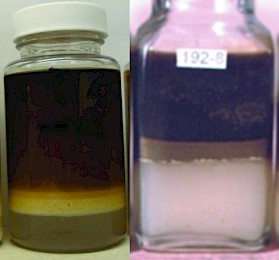
When oil-water mixtures are at rest, stratification occurs based on oil density, polarity and Stoke’s Law. This is seen hypothetically in the illustration of Figure 2 and the photo images of the oil samples in Figure 3. Violently agitating an oil contaminated with water in a sample bottle and then letting it rest helps us understand more about both the oil and the water (also air release and foaming tendency). Very similar to the blender test for field inspection of oil conditions (use our search engine for more information on this method).
35 Things that Aren’t Going Wrong
Have a good sight glass centre-line with your machine’s target oil level. Have another one at the sump bottom (BS&W bowl). Let’s say that you visually inspect your machine with good light at both locations. All you see is clear and bright oil of the right colour. What can you conclude? Well, there are about 35 things that could be going wrong with your oil and machine but you know are not going wrong (see sidebar) due to this simple visual inspection, including the harmful presence of water. Do it!
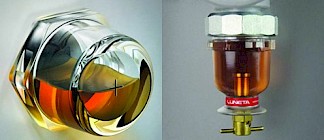 35 things that are not happening when oil is clear, bright and the correct colour when observed at both the oil level sight glass and the BS&W sight glass (some exceptions apply):
35 things that are not happening when oil is clear, bright and the correct colour when observed at both the oil level sight glass and the BS&W sight glass (some exceptions apply):
- Oil is NOT oxidized
- Oil additive system is NOT instable
- Oil is NOT contaminated with free water
- Oil and water are NOT emulsified
- Oil is NOT laden with heavy varnish potential
- Oil is NOT hydrolyzed
- Oil does NOT contain sludgy suspensions
- Oil is NOT cross-contaminated with another lubricant
- Oil additives have NOT turned to floc from chemical degradation
- A wrong oil is NOT being used
- The fishbowl effect is NOT happening (Google: noria fishbowl effect)
- Filter has NOT burst or not gone into bypass
- Oil is NOT loaded with sediment or stratified solids
- Oil is NOT thermally degradation
- Oil is NOT loaded with soft organic insoluble from various sources
- Oil does NOT have impaired air release properties
- Oil is NOT exhibiting foam tendency/stability problems
- Oil does NOT have microbial contamination
- Oil does NOT have severe corrosive potential
- Oil does NOT need to be immediately changed for various reasons
- Antifreeze contamination has NOT occurred
- Abnormal levels of particle or water ingression conditions are NOT occurring
- Advanced wear debris generation is NOT likely occurring
- Machine is NOT starved of oil due to low oil level
- Machine is NOT dangerously flooded with oil
- Machine sump/reservoir is NOT over-agitated for various reasons
- Circulating machine does not have a suction line air-induction leak
- Process chemicals/liquids have NOT invaded the lubricant
- The desiccant breather and general headspace management are NOT malfunctioning
- Machine is NOT likely to have hotspots
- Severe misalignment is NOT likely to be occurring
- Precipitous gear or bearing failure is NOT likely to be occurring
- Process gases have NOT invaded the lubricant system
- Failure of internal or external seals does NOT appear to have occurred
- Negligent PMs and inspection practices do NOT appear to be occurring
